Post-implementation Review in Project Management: Explained
Learning from past experiences is probably one of the most efficient learning techniques.
In the context of project management — post-implementation reviews are the best tool to assist you on your project growth journey.
The review will serve as a guiding light for all your future projects by explaining the reasons for project success or failure.
In this guide, we’ll explain all the basics of a post-implementation review and cover:
- What the post-implementation review is,
- When, why, how, and by whom it should be conducted,
- What the common barriers are, and
- 10 tips to overcome these barriers.
Whether you’re a project manager or a project team member — this guide should deepen your project management skills.
So, keep reading.

Table of Contents
What is the post-implementation review (PIR) in project management?
The post-implementation review (sometimes referred to as the post-project review or the post-mortem review), is a formal project performance assessment that serves to establish some of the following:
- Whether the project has achieved the intended results,
- How certain project activities have performed,
- Why a project failed to meet desired objectives, and
- What can be done to improve future projects.
The PIR is an important part of the entire project planning, as it doesn’t only answer whether the project succeeded, but it also uncovers far more important insights such as:
- If the project did succeed, to what extent did it succeed?
- What are the underlying reasons for its success/failure?
These insights are extremely useful as they can be applied in all future projects in the form of lessons learned (a term commonly used by the Project Management Institute).
When to conduct the PIR
Generally speaking, the PIR is in most cases conducted during the final project phase — the project closure phase.
In more specific terms, if you want to be able to analyze the project and its outcomes — you need to actually finish the project.
Perhaps the best moment to conduct the PIR is after the project has been formally implemented.
You should choose the timing for the PIR carefully as:
- Conducting it too early, you might overlook outcomes that require more time to pass to fulfill, whereas
- Conducting it too late, you might miss the opportunity to apply the lessons learned to other projects.
Depending on the project duration and complexity, you can choose to conduct the PIR periodically, to assess both:
- Short-term outcomes (to assess project benefits and value shortly after project completion), or
- Long-term outcomes (to assess its full impacts after longer time periods have passed).
Certain organizations might even choose to conduct the PIR the moment they hit an important project milestone, to check if there’s a need for some adjustments or changes during the project implementation phase.
In the diagram below, you can see the possible timing for conducting the PIR:
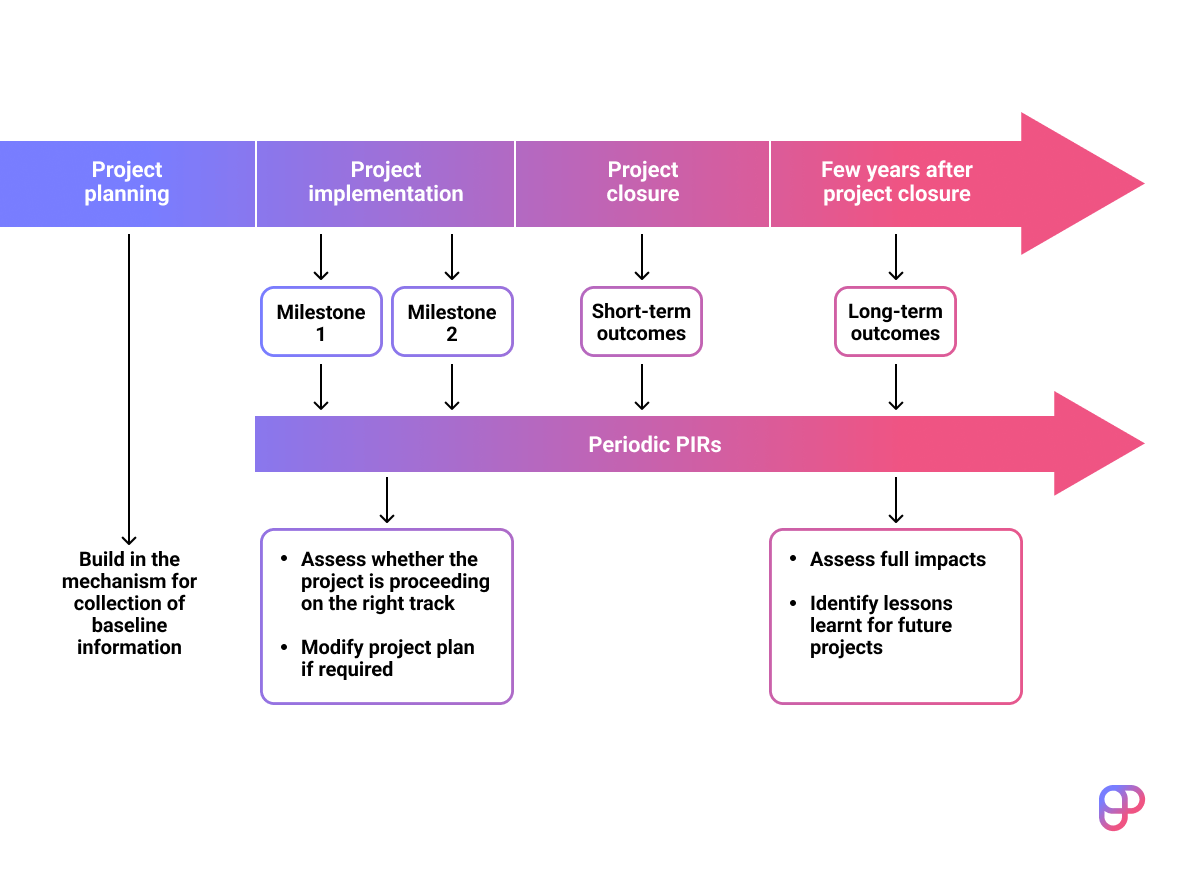
It’s important to note that you should plan the PIR in advance.
As soon as the initial project planning phase begins, skilled project managers (PMs) should know what planning documents they’ll need later for the PIR.
These documents include project management plans — e.g. a project scope plan or a work breakdown structure.
Who should be involved in the post-implementation review?
Dragan Z. Milosevic and Russ J. Martinelli suggest in Project Management Toolbox that a “well-respected” and “non-biased” person should be in charge of information gathering for the PIR.
Milosevic and Martinelli do not recommend the project manager to be the post-mortem review facilitator, probably because the project manager might be too emotionally involved with the project.
An independent team, or someone outside the project team, will focus on gathering facts with objectivity.
On the other hand, project team members might be able to conduct the review more efficiently and within a shorter period, as they are already familiar with the project.
Another option is to include both the original project team and an independent team in the review to get two perspectives on the project.
Why should you conduct a post-implementation review (PIR)?
Suppose you’ve completed a project successfully — how can you repeat the success if you don’t know what actions led you to it?
Or, if you have failed — how can you perform better next time if the reasons for project failure are too vague?
Conducting the post-implementation review should help you pinpoint the reasons.
According to the article Post-project reviews as a key project management competence, people don’t automatically learn from their past project experience. On the contrary, most people need their learning to be structured.
Also, the knowledge of what happened during a project is often scattered among team members, making it essential to share insights within the team.
A post-implementation review should help you:
- Understand all cause-and-effect relationships that lead to project failure/success, and
- Identify opportunities for further improvement and growth.
Specifically, the PIR helps you:
- Understand the differences between the original scope and the result,
- Analyze project team performance,
- Discover what project methodology best suits a specific project,
- Learn what good practices you should apply to future projects, and
- Learn what actions you should avoid in future projects.
You can identify the problematic areas in the project management process by analyzing recurring patterns and events within a project, such as:
- Frequent request changes,
- Frequent disputes regarding quality, or
- Frequently missed project deadlines.
In essence, a PIR is a learning process and should be an opportunity to improve your project planning.
How to make a post-implementation review in 6 steps
Suppose you’re not sure where to start with the review. In that case, our suggestion is to divide the PIR process into several steps:
- Step #1: Review existing documents and plans,
- Step #2: Collect feedback from the people involved in the project,
- Step #3: Use a checklist to facilitate gathering data,
- Step #4: Conduct a meeting with the project team,
- Step #5: Identify lessons learned, and
- Step #6: Make a post-implementation review report.
Now, let’s analyze the 6 steps in more detail.
Step #1: Review existing documents and plans
The first step of the PIR review is to collect all existing documents and plans for the project you’re reviewing.
For example, a project charter is a place to start, as it contains all the relevant information about the project.
In the project charter, you should have all your project goals and objectives clearly outlined and ready for comparison with the actual project deliverables.
Step #2: Collect feedback from the people involved in the project
After gathering the documents, you can move on to collecting data from people involved in the project, including:
- Project team,
- Users/customers, and
- Project stakeholders.
It’s good to use several information-gathering techniques (e.g. questionnaires, surveys, or face-to-face interviews) to collect all the necessary data, as it increases data objectivity.
Step #3: Use a checklist to facilitate gathering data
Generally, project checklists are a great way to improve your team’s efficiency and organization.
Using a simple checklist as a part of the PIR process facilitates information gathering as you can easily collect information that can be further examined and discussed in meetings with the project team.
In Project Management Toolbox, there’s an example of a checklist with questions divided into different project categories that you can ask the project team.
It’s best if the questionnaire is anonymous, as the responses will be more honest and realistic.
Here’s what the PIR checklist may look like:
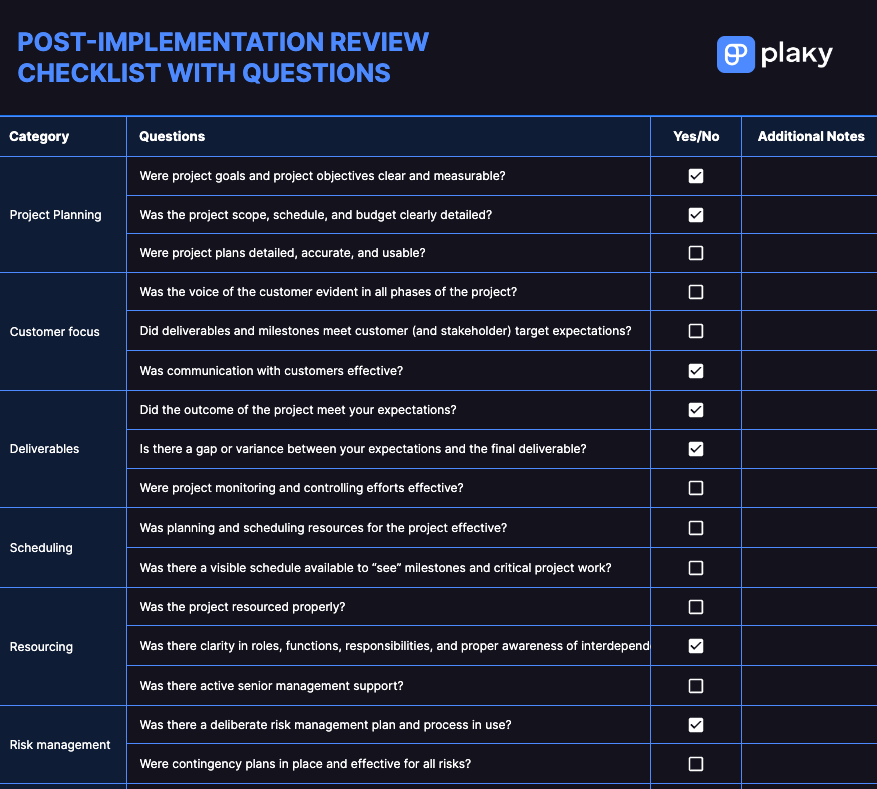
⏬ You can get the PIR checklist template here.
Step #4: Conduct a meeting with the project team
Meetings are an excellent opportunity to analyze the information you’ve gathered about the project and further discuss the review with your team.
Apart from the information gathered, according to Milosevic and Martinelli, it’s nice to have an agenda prepared before the meeting.
Here’s what a post-project review meeting should generally look like:
- Welcome and introduce participants,
- Review the ground rules of the meeting,
- Summarize the collected information,
- Review and analyze issues and critical success factors,
- Create a list of what went wrong,
- Create a list of what went right,
- Identify opportunities for improvement with actionable recommendations, and
- Outline specific steps for the future.
Using team communication skills in review meetings will significantly improve the outcomes of the entire review process.
Step #5: Identify lessons learned
The PMBOK® Guide (Seventh edition), defines lessons learned as “the knowledge gained during a project, which shows how project events were addressed or should be addressed in the future, for the purpose of improving future performance.”
Lessons learned are an integral part of the PIR process as they help you identify both good and bad actions in a project.
You can also choose to create lessons learned log that consists of:
- Change or performance consequence,
- Cause,
- Lessons learned,
- Action, and
- Process change recommendation.
Here’s what the basic lessons learned log may look like:
| Lessons learned log | Notes |
|---|---|
| Consequence | Two people completed the same task assuming nobody was assigned, which caused the company to unnecessarily miss planned deadlines. |
| Cause | Team members didn’t have access to other team members’ tasks. |
| Lesson learned | There’s often confusion about who’s doing what when there’s no clear overview. |
| Action | The company started using Plaky project management software for assigning tasks. |
| Process change | Use project management software to improve task transparency. |
A visual display of cause-and-effect relationships can help you outline good and bad actions for future projects and deliver the best results possible.
Step #6: Make a post-implementation review report
For the review to be effective, all insights should be documented and shared with the project team in a written report.
If you don’t know where to start — try using a pre-made PIR report template.
A pre-made template will serve as a guideline and save you valuable time making the report from scratch.
Here’s what a PIR report looks like:
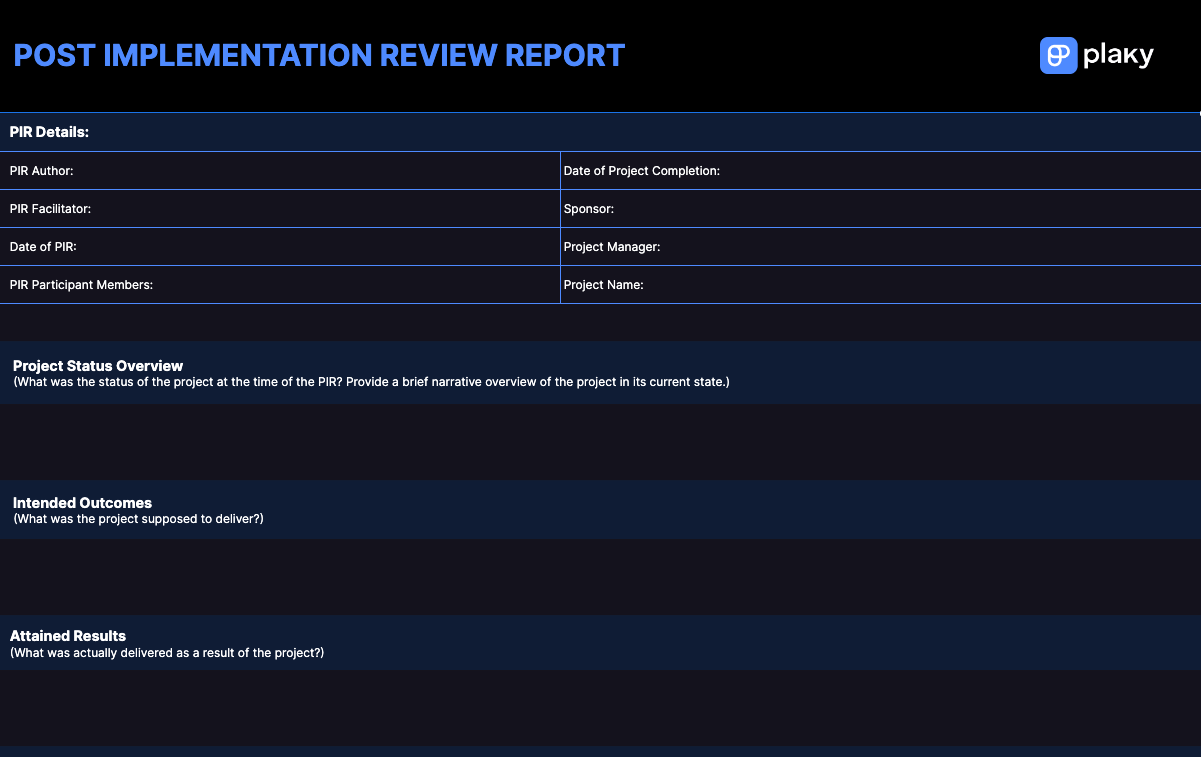
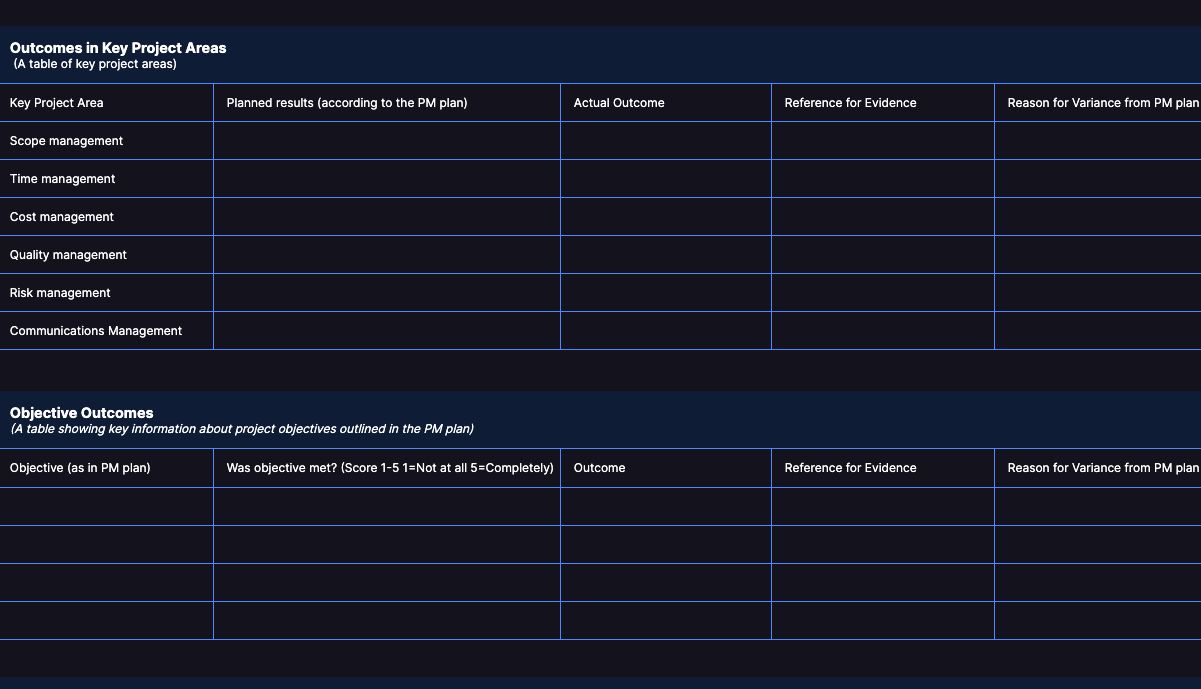
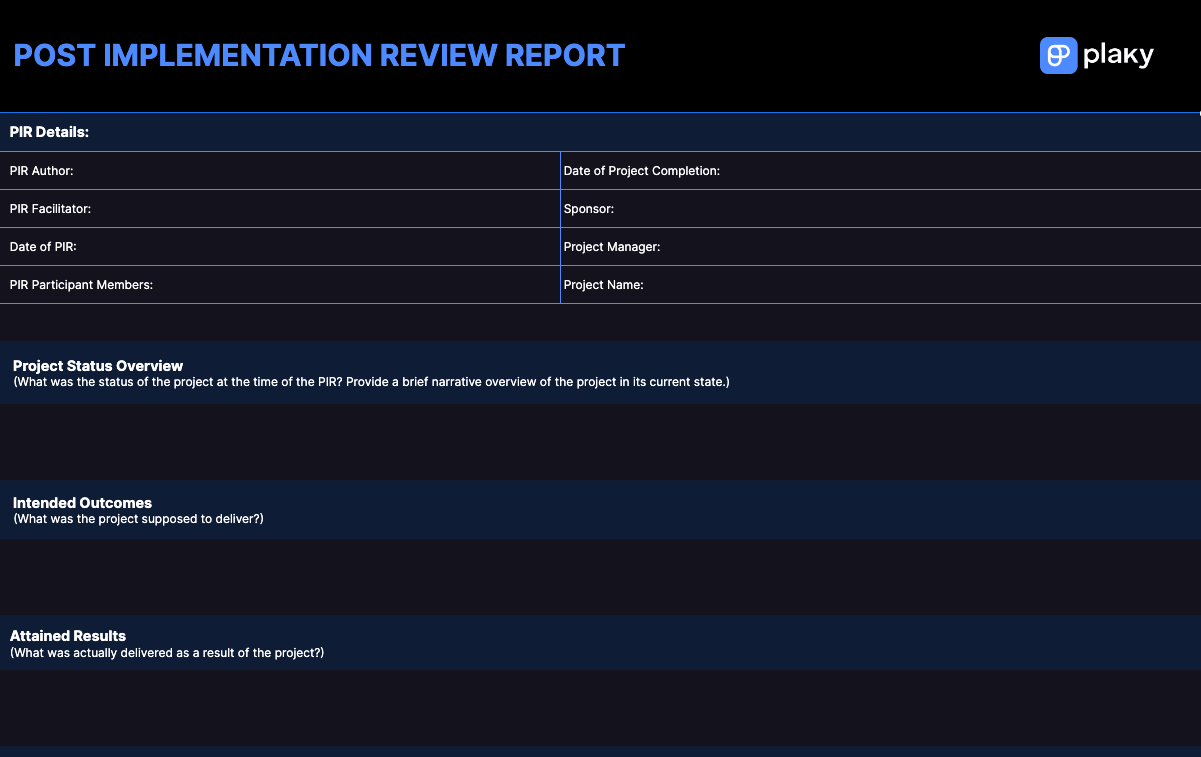
Generally, the PIR report should contain the following information:
- Project details,
- Project status,
- Project background, including objectives and scope,
- Objective outcomes including variations,
- Any challenges to the PIR process,
- Methodology overview,
- Reasons for success/failure,
- Lessons learned, and
- Any additional recommendations for future projects.
⏬ You can get the PIR report template here.
6 Common barriers to the PIR and how to overcome them
Even though the PIR has many benefits, conducting the review can become quite a challenge.
According to the research on post-project reviews in construction, there are some common barriers to the PIR process, including:
- Lack of time,
- Lack of budget,
- Ambiguous objectives,
- Lack of documentation,
- Lack of awareness about the PIR value, and
- Lack of positive attitudes toward the PIR.
Now, let’s analyze these barriers in detail and offer solutions.
Barrier #1: Lack of time
Post-project reviews are often time-consuming. Project teams tend to find themselves caught up in a new project shortly after they’ve closed the previous project.
Chasing project deadlines and managing multiple projects, organizations usually lack the time to evaluate what’s already behind them.
Therefore, project teams should include the PIR as a part of the project time management plan.
Barrier #2: Lack of budget
From the very beginning of the project, it should be made clear that conducting the PIR will require additional resources.
To avoid unplanned expenses, project directors and project sponsors should include the PIR as a part of their project budget plan on time.
Barrier #3: Lack of clear objectives
The review team should set clear objectives to avoid missing important information from the PIR.
To define PIR objectives effectively and avoid ambiguity, you can:
- Consult key stakeholders about the specific areas that need to be addressed in the PIR, and
- Define the PIR scope.
Barrier #4: Lack of documentation
One of the common barriers to the PIR often stems from practical issues, such as a lack of project documentation.
You won’t be able to start the review if you don’t have the necessary documents and plans.
You should appropriately maintain all project data to use it for the post-project review.
Barrier #5: Lack of awareness about the PIR value
It’s not uncommon for project teams to miss the real value of the post-implementation review.
Organizations should raise awareness about the need for the PIR through training and orientations.
Raising awareness will clarify PIR’s many benefits, such as learning from past projects to reduce errors in future projects.
Barrier #6: Lack of positive attitudes toward the PIR
Post-implementation review is often wrongly perceived as finger-pointing and placing blame for poor performance issues.
In reality, project teams should try to accept the PIR process as an opportunity for:
- Growth,
- Learning, and
- Improvement.
Reviews should be free from negativity, and all participants should feel free to contribute without fear of judgment.
10 Tips for a successful post-implementation review
In Project Management Toolbox, Milosevic and Martinelli highlight the post-project review meetings as the crucial part of the post-project review process.
They offer a list of the top 10 best practices for successful post-project review meetings that may be used as general tips for conducting the PIR.
Tip #1: “Start early.”
A proven way to ensure that project teams commit themselves to the PIR is to plan the PIR in the early phases of project development and make it an incremental part of project planning.
Tip #2: “Establish your team culture.”
Project team members should all know how each of their responsibilities contributes to the common goal.
Cultivating a positive team culture of trust among team members facilitates the later review process and results in an honest post-project review.
Team members working toward a shared objective will perceive the PIR as an opportunity to learn and improve together, not as criticism.
Tip #3: “Know your measures of success.”
The project team should be well acquainted with the key points that will be analyzed during the PIR from the very beginning of the project.
Being familiar with the critical success factors and the project’s key performance indicators, you will know what’s relevant for the post-implementation review, as well as how to measure results.
Tip #4: “Use experts.”
In post-project review meetings, it’s good to have an unbiased person as a facilitator, as their expertise can determine whether the meeting will be productive.
Tip #5: “Ensure representation.”
There should be an equal representation of all teams involved in the project.
Tip #6: “Everyone contributes”.
Every team member should have an equal chance to participate in the post-project review and thus contribute with their thoughts and ideas.
Tip #7: “Work from facts.”
Facts and objective project information should have priority over subjective opinions.
Tip #8: “Focus on the future.”
Though the review is based on a finished project, the focus should stay on the future and how to improve ongoing and upcoming projects.
Tip #9: “Detail the conversation in narrative form.”
Information gathered through interviews should be presented in the form of a narrative, rather than in a bullet-point list.
Lists can be rather vague, while narratives are more descriptive, precise, and useful, especially for complex projects.
Tip #10: “Broadcast your results.”
The PIR report should be shared among all project teams and easily accessible for future reference.
📖 Post-implementation review is just one of the terms that you’ll be expected to understand as a project worker. To learn more about other project management terms, you can always refer to our Project Management Glossary of Terms.
Improve efficiency and make PIR easier with Plaky
The best way to ensure your project remains on track and meets its goal without the threat of scope creep is to use the right tool for the job.
With a specialized project management app such as Plaky, you can:
- Maintain a clear overview of project progress,
- Manage individual tasks,
- Have insight into all project activity,
- Keep all project documentation stored in one place,
- Communicate with team members via task-specific threads,
- Effortlessly share files, and more.
Plaky offers unlimited storage on all plans, although there is a limit on the size of individual files — 10 MB, 25 MB, and 100 MB for the Free, Business, and Enterprise plans respectively.
The only way to know if Plaky is the right fit for your team is to try it out for yourself. You can create a free Plaky account and test the app out first-hand, and you can use the free plan indefinitely with no commitment.
References
- Anbari, F. T., Carayannis, E. G., & Voetsch, R. J. (2008). Post-project reviews as a key project management competence. Technovation, 28(10), 633–643. https://doi.org/10.1016/j.technovation.2007.12.001
- A user guide to post implementation reviews (February 2009). Retrieved December 22, 2022, from https://www.effo.gov.hk/en/reference/publications/pir.pdf
- Martinelli, R. J., & Milošević Dragan. (2016). Project Management Toolbox: Tools and techniques for the practicing project manager. Wiley.
- Oyewobi, L. O., Jimoh, R. A., Suleiman, B., & John, M. (1970, January 1). Post-project reviews in construction: A means to achieving improved projects performance. Retrieved December 22, 2022, from http://repository.futminna.edu.ng:8080/jspui/handle/123456789/600
- PMI. (2021). A guide to the Project Management Body of Knowledge (PMBOK® Guide) and the standard for Project Management
 Project Management Hub
Project Management Hub 











